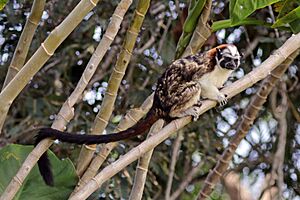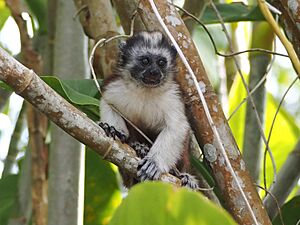Geoffroy's tamarin facts for kids
Quick facts for kids Geoffroy's tamarin |
|
|---|---|
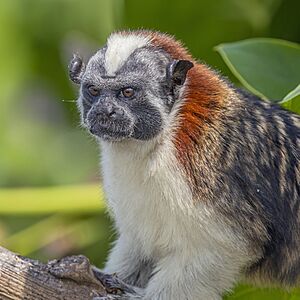 |
|
| Gatun Lake, Panama | |
| Conservation status | |
| Scientific classification | |
| Genus: |
Saguinus
|
| Species: |
geoffroyi
|
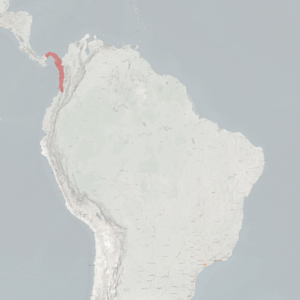 |
|
| Approximate range of the Geoffory's Tamarin | |
| Synonyms | |
|
|
The Geoffroy's tamarin (Saguinus geoffroyi) is a small monkey. It is also known as the Panamanian, red-crested, or rufous-naped tamarin. You can find this tamarin in Panama and Colombia.
This monkey is mostly black and white. It has a reddish patch on the back of its neck. Geoffroy's tamarins are diurnal, which means they are active during the day. They spend most of their time in trees. Sometimes, they come down to the ground. They live in groups, usually with three to five monkeys. These groups often have both male and female adults.
Geoffroy's tamarins eat many different foods. Their diet includes insects, tree sap, fruits, and other plant parts. Insects and fruits are their main foods. Tree sap is also important. However, their teeth are not made for cutting into trees to get sap. So, they only eat sap when it is easy to find.
A female tamarin is usually the only one in the group to have babies. She might mate with several males in the group. After about 145 days, she gives birth to one or two babies. Male tamarins help a lot with caring for the young. These monkeys become adults at about 2 years old. They can live for up to 13 years. The IUCN lists Geoffroy's tamarin as "near threatened." This means their numbers are decreasing, but they are not yet in immediate danger.
Contents
What is a Geoffroy's Tamarin?
A Small New World Monkey
Geoffroy's tamarin is a type of New World monkey. These monkeys live in Central and South America. It belongs to a group called Callitrichidae, which includes other tamarins and marmosets. These are all very small monkeys.
Scientists once thought Geoffroy's tamarin was a type of cotton-top tamarin. The cotton-top tamarin lives only in Colombia. But newer studies show they are different species. They look similar, but their bodies and genes are not quite the same. These two species separated about 1.2 million years ago.
How Geoffroy's Tamarins Look
Physical Features of This Monkey
Geoffroy's tamarin is a small monkey, like other tamarins and marmosets. It is the smallest monkey in Central America. Its body is about 225 to 240 millimetres (8.9 to 9.4 in) long, not counting its tail. The tail itself is between 314 and 386 millimetres (12.4 and 15.2 in) long.
Male tamarins weigh about 486 grams (17.1 oz). Females are a little heavier, at about 507 grams (17.9 oz). The fur on their back is a mix of black and yellow. Their legs, feet, and chest are pale. Their face has very little fur. Their head has reddish fur with a triangle shape at the front. The tail is reddish-brown with a black tip.
How Geoffroy's Tamarins Behave
Daily Life and Group Living
Like all tamarins, Geoffroy's tamarin is active during the day and lives in trees. Unlike some other monkeys, it sometimes comes down to the ground. This usually happens only when it needs to find certain foods or reach a tree it cannot jump to.
Groups usually have three to nine monkeys. Most often, there are three to five. Groups often have more than one adult male and female. Adult monkeys of both sexes can move between different groups. These groups protect their home areas. In some places, you might find 3.6 to 5.7 monkeys per square kilometer. In other areas, there can be as many as 20 to 30 monkeys per square kilometer. On average, a Geoffroy's tamarin travels about 2061 meters each day. Their home range can be between 9.4 and 32 hectares.
How They Communicate
Geoffroy's tamarins communicate using sounds and body movements. They make sounds like whistles, twitters, trills, and sharp notes. They also make sneezes and long rasps. When they want to show aggression, they stand on their hind legs. They also make their white fur stand up. Females often show they are ready to mate by quickly coiling their tails.
Moving Through the Trees
Geoffroy's tamarins move differently from squirrels. Squirrels often climb up and down tree trunks. Tamarins usually avoid large, straight tree trunks when they travel. They prefer to move across thin branches. They go up and down by making long leaps. If they do use large trunks, they use them more for climbing up than for climbing down.
Avoiding Other Animals
Geoffroy's tamarins usually stay away from other small and medium-sized monkeys. These include the white-headed capuchin and the Panamanian night monkey. They avoid capuchins by staying in different parts of the forest. They avoid night monkeys because night monkeys are active at night, and tamarins are active during the day.
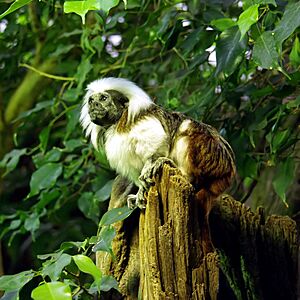
Tamarins are rarely seen near squirrels. This is because squirrels seem to avoid the larger tamarins. Geoffroy's tamarins usually try to escape when birds of prey come near. This happens even if the bird is not truly dangerous. However, they ignore one bird, the double-toothed kite. This kite sometimes follows tamarins. It seems to want to eat small animals that the tamarins disturb.
The diet of Geoffroy's tamarin is similar to some tyrant flycatcher birds in Panama. They even make similar sounds. Tamarins might use the flycatcher calls to help find good food sources. The flycatchers and tamarins are active at different times. This helps them avoid competing for the same food. Flycatchers are most active after sunrise and rest in the middle of the day. Tamarins start moving about 45 minutes after sunrise. They stay active for most of the day until about an hour before sunset.
What They Eat
Geoffroy's tamarin eats many different things. Their diet includes fruits, insects, tree sap (gums and saps), and green plant parts. What they eat changes with the seasons. One study found their diet was about 40% insects, 38% fruit, 14% tree sap, and 8% other items. The tree sap mostly came from Anacardium excelsum cashew trees. Another study showed 60% fruit, 30% insects, and 10% green plant parts. This included a lot of sap from elephant ear trees (Enterolobium cyclocarpum).
Another study found their diet was about half insects (mostly grasshoppers) and half fruit. Unlike marmosets, tamarins do not have teeth made for cutting into trees. So, Geoffroy's tamarin only eats sap when it is easy to get. They usually hunt for insects by moving quickly on thin, bendy branches. But they eat sap while holding onto large, straight tree trunks.
In one study, Geoffroy's tamarin drank water from the flowers of Ochroma limonesis. They are also thought to drink from holes in trees, like other tamarin species.
Life Cycle and Reproduction
Geoffroy's tamarins can have babies all year. But most births happen from April to June. A mother can have one baby or twins. It is common for one of the twins to not survive the first few months. The mother is pregnant for about 145 days. This is similar to the cotton-top tamarin.
The time between births is usually between 154 and 540 days. The average is 311 days. The time is longer after twins are born. Babies weigh between 40 and 50 grams (1.4 and 1.8 oz) when they are born. They are born with full fur. The baby's fur is a different color from its parents'. Babies have black fur on their body and tail. They have a beige stripe and a white face. The baby's colors make the white less noticeable. White is often used in aggressive displays by adult tamarins.
Both mothers and fathers help care for the babies. Typically, only one adult female in a group has babies. If she has the chance, she will mate with several males. Males carry and groom the babies more than females do. Older brothers and sisters might also help care for the babies. However, babies prefer to be carried by their parents.
Babies start moving around at 2 to 5 weeks old. They begin eating solid food at 4 to 7 weeks. They become independent at 10 to 18 weeks. They stop drinking milk at 15 to 25 weeks. Geoffroy's tamarin becomes ready to have its own babies at about 2 years old. They can live for up to 13 years.
Where Geoffroy's Tamarins Live
Habitat and Distribution
Geoffroy's tamarin lives in different kinds of forests. This includes old-growth forests and newer forests. They live in both dry and moist tropical forests. In Panama, they like newer forests with some humidity.
You can find them in central and eastern Panama. Their range goes a little west of the Panama Canal zone. They have been seen as far west as Altos de Campana National Park. They are less common on the Atlantic coast of Panama. They are only common on the Atlantic coast near the Canal zone where people have changed the land. You can even find them in Metropolitan Natural Park, a park inside Panama City.
In Colombia, they live on the Pacific coast, west of the Andes mountains. Their range goes south to the Rio San Juan. People once thought their eastern boundary in Colombia was the Rio Atrato. But they have been seen further east, including in Las Orquídeas National Natural Park. Older reports sometimes said they lived in southern Costa Rica. But these reports are probably wrong.
Protecting Geoffroy's Tamarins
Conservation Status
The International Union for Conservation of Nature says Geoffroy's tamarin is "near threatened". The biggest danger to them is deforestation. This is when forests are cut down. This causes their numbers to go down in some areas. However, they can adapt to some changes in their habitat.
People in Panama also sometimes hunt them. They are also caught to be sold as pets. A study in Panama in 1985 found that there were more Geoffroy's tamarins in places where people could not easily go. Human activity in Panama can be both good and bad for Geoffroy's tamarin populations. Hunting makes their numbers go down. But cutting down old forests for farming creates more new forest growth. This new growth is good for the tamarin.



